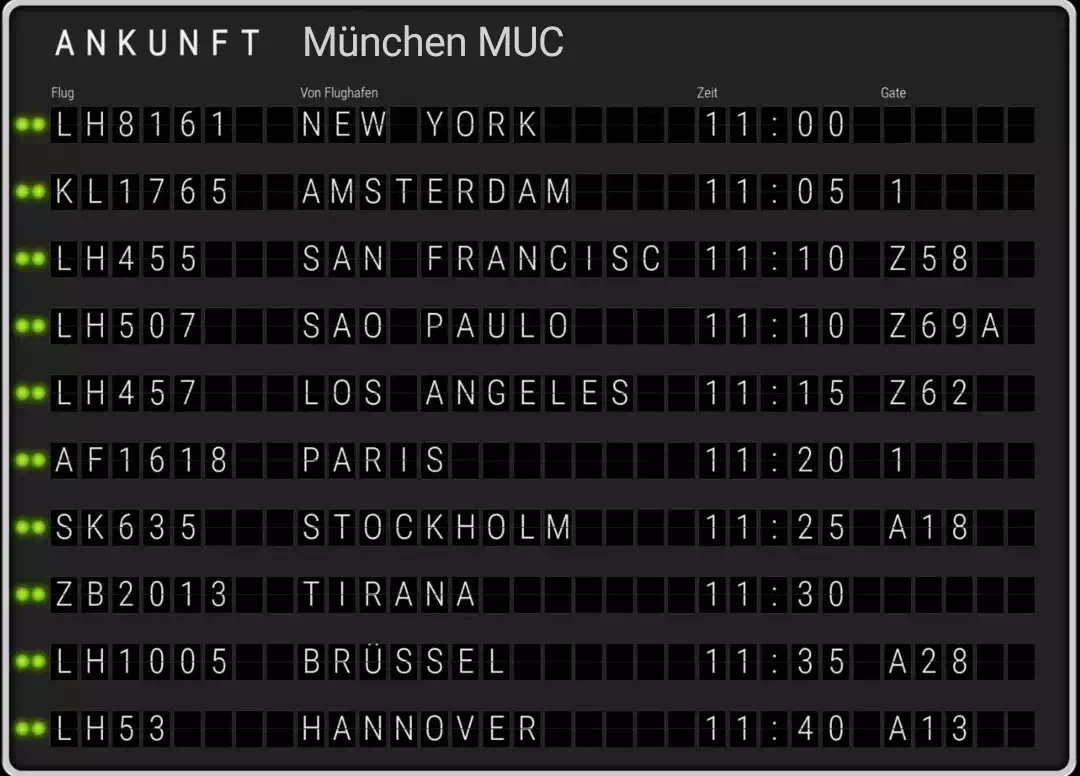Arrivals Munich MUC Airport

Landings scoreboard
Arrival - Departure - About - Flight status - Codeshare - Terminal - Hall - Gate with arrivals Munich Airport Today on 10.10.2025
arrival arrival times arrivals landing times Airport Munich Airport "Franz Josef Strauss" - Arrival Munich today Friday 10.10.2025
Arrival Airport Munich
Terminal 1 is the older terminal and commenced operation when the airport was opened on 17 May 1992. It has a total capacity of 25 million passengers per year and is subdivided into five modules designated A, B, C, D and E. Modules A through D provide all facilities necessary to handle departures and arrivals, including individual landside driveways and parking, whereas module E is equipped to handle arrivals only. This design essentially makes each module a self-contained sub-terminal of its own. Modules A and D are used for flights within the Schengen-area, while modules B and C handle those to destinations outside it. Hall F is separate, located near Terminal 2, and handles flights with increased security requirements, i.e. those to Israel. Furthermore, the check-in counters for some flights departing from Terminal 1 are located in the central area Z (German: Zentralbereich) where most of the shopping and restaurant facilities of this Terminal as well as the airport's suburban railway station are also located.
The 1,081-metre (3,547-foot) pier features 21 jet bridges, two of which have been rebuilt into waiting halls for bus transfers. One gate position has been equipped with three jet bridges to handle the Airbus A380 which is regularly used by Emirates. There are further 60 aircraft stands on the apron, some of which are equipped with specially designed apron jet bridges (German: Vorfeldfluggastbrücken), to which passengers are brought by bus. This unique concept allows passengers to board with full protection from the weather but without the high investment required for full satellite terminals connected through a passenger transport system.
Terminal 1 currently handles all airlines that are not members or partners of the Star Alliance with the exception of Turkish Airlines. However, owing to lack of capacity at Terminal 2, Lufthansa's subsidiary Germanwings and former affiliate Condor both moved back to Terminal 1 in 2007. Germanwings however moved back to Terminal 2 in late 2015. Some of the major users at Terminal 1 are Condor, Eurowings, Emirates, Qatar Airways, American Airlines, Delta Air Lines, easyJet and TUI fly Deutschland amongst several others.
Terminal 2 commenced operation on 29 June 2003. It has a design capacity of 25 million passengers per year and is exclusively used by Lufthansa and all other Star Alliance members serving Munich except Turkish Airlines. Star Alliance partners Air Malta and Luxair also use Terminal 2. Etihad Airways relocated to this terminal as well after commencing a partnership with Lufthansa.
Having been designed as a hub terminal, it is not divided into modules like Terminal 1. Instead, all facilities are arranged around a central Plaza. Owing to security regulations imposed by the European Union, the terminal has been equipped with facilities to handle passengers from countries considered insecure, i.e. not implementing the same regulations. This required the construction of a new level as, unlike other airports, the terminal does not have separate areas for arriving and departing passengers. The new level 06 opened on 15 January 2009.
The pier, which is 980 m (3,220 ft) long, is equipped with 24 jet bridges. As the total number of 75 aircraft stands on the east apron is not always sufficient, Terminal 2 sometimes also uses parking positions on the west apron, to which passengers are carried by airside buses. Terminal 2 is able to handle the Airbus A380 as well, however, prior to the opening of the Terminal 2 satellite building, there were no designated stands or additional jet bridges for it. Lufthansa flies the A380 into the satellite building.
Terminal 2 has two main departure levels, 04 and 05 and additional bus gates on the lower level 03. Gates on level 05 (H) are designated non-Schengen gates. Until the new transfer level 06 opened, the northernmost gates were behind an additional security checkpoint for departures to the USA most of the day. The lower level 04 (G) contains Schengen gates. The bus gates on level 03 are also designated G and are also used for Schengen flights. Level 03 is smaller than the main levels and consists of two separate parts which can be reached from two points on level 04. One area of these gates is designated to Air Dolomiti.
Arrival and baggage
In the main building, Level 03 is the arrivals level on the land side. This level is the transition from Terminal 2 to the Munich Airport Center and thus also to Terminal 1. The baggage claim belts are located on the air side on this floor, from which you can go directly to the public area can go. There are also some check-in counters on level 03, for example United Airlines. The luggage sorting system is located on this level, not visible to the passenger, both in the main building and in the satellite.
Arriving from countries requiring a visa
Level 06 is the arrival level for passengers from visa-required countries. Passengers from visa-exempt countries are also directed to level 06 if the final destination is Munich. From there you can go through passport control to baggage claim. In the event of a transfer, all passengers arriving from a country that requires a visa must first go through a security check and from there reach the non-Schengen area on level 05. The security check is located in the satellite on level 06, but in the main building on the level 05. This is due to the fact that level 06 in the main building was subsequently built from 2007 to January 15, 2009 as a glass corridor from the roof. In the main building, not all gates are equipped with a connection to level 06, which limits aircraft positioning.
Source: Flugreise-Muenchen.de